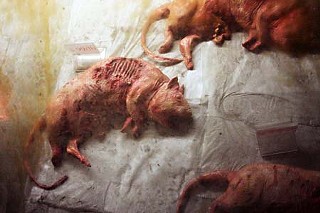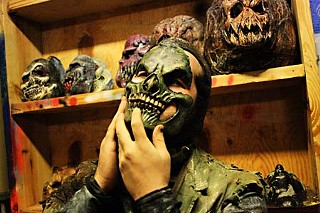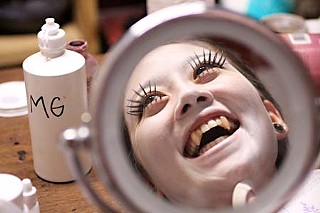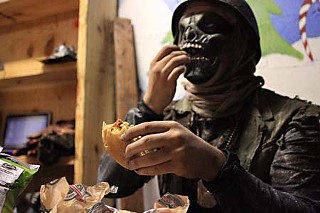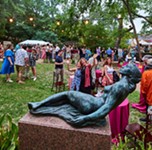It Came From the Back Yard
House of Torment's yearlong scare tactics pay off in seasonal screams
By Richard Whittaker, Fri., Oct. 3, 2008
For 46 weeks a year, it's a nondescript concrete box in the Highland Mall parking lot. For the six weeks leading up to Halloween, the House of Torment is a gore-drenched charnel house, an apocalyptic hellscape draped with shattered corpses and patrolled by twisted creatures that has become a must-see for horror fans and scare seekers. Every year, the local business sets new standards in artistry and technical complexity, and the national Halloween industry is paying attention.
The four chambers of its blackened, beating heart are the four permanent members of Team Torment. Founder, chief mechanic, and all-around head of the household Dan McCullough welds and solders the brute machinery that makes the haunt wail and lunge at customers. Jon Love, the business manager, runs the front of the house while balancing the budget. Then there are the brothers Garcia: Mike, the operations manager, wrangles the actors and runs the behind-the-scenes crew, while Matt – often to be found surrounded by piles of sketches or latex-covered creations – is the artistic director who designs the props and costumes, down to each groove on each fang of each lurking beast. "It's like having an all-star team," explains Matt.
After massive success during Halloween 2007, the team took the dramatic step of sinking everything into the project, quitting their day jobs, and taking the entire year to work on the house. Even before opening for 2008, there was a good omen: The house was named the nation's sixth best professional haunt by Halloween industry bible Hauntworld. "Every year they do a national ranking list, and every year we look at it and think, 'Wow, it would be nice to be recognized,'" says McCullough. "This was our first year to be nominated, and to be up there at number six, above some of the best haunted houses we'd ever seen, really makes us proud of what we've done here." Not bad for something that started in McCullough's yard 13 years ago.
"As a kid growing up in Austin," he explains, "Halloween was a big event. I liked going 'round and seeing yard setups, a werewolf in a cage in a garage – anything that gives a little show for trick-or-treaters." That first year, about 30 people turned up. After a few years, the hundreds of visitors he attracted were tearing up his lawn. So in 2002, armed with a $10,000 loan and what McCullough calls "a bunch of brother-in-law deals," the house went professional. "We didn't have much of a clue what we were doing, but we knew that we had the determination to get it done," he says. Now, on a good night, anywhere between 2,000 and 4,000 customers visit the house.
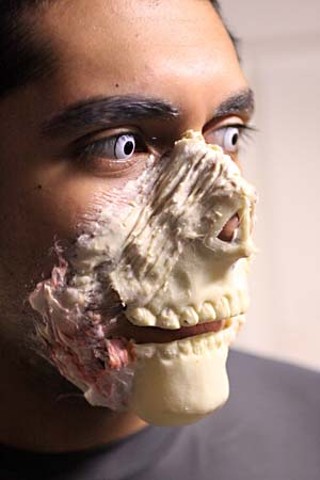
Under all the prosthetic scars and movie-level effects, it's a business. In fact, Halloween is an industry, and sometimes it's cutthroat (that's why some staff must sign nondisclosure agreements – to protect proprietary designs from rivals). In revenue terms, it's the No. 2 holiday, behind only Christmas, with trade shows, conferences, and a cadre of prop and costume companies. The International Association of Haunted Attractions, the haunted house industry's trade body, expects national spending to top $5 billion. It's a complex business model, which is where Jon Love – a graduate of the University of Texas' McCombs School of Business – comes into his own. Love did his student corporate finance internship under McCullough (his first sales job – explaining to his professors that the house is a real business). After graduating and briefly enduring a soul-crushing corporate job, which he calls his real house of torment, he returned to manage the house, where 10 months of building and design pay off in six weeks of tickets sales. Part of his job is ramping the house up to speed from the development stages to opened doors, hiring additional production and sales staff, enforcing the drug-testing policy, dealing with permitting issues, buying merchandise, and setting up marketing and promotional deals. "It's a logistical process," he says. "We'll have more people working here than ever before: 100 on a busy night."
Like all business owners, McCullough learned the cardinal rule is location, location, location: That's a particular challenge for a business that, between starting construction and shuttering the doors after Halloween, may only be there four months. "That's where a lot of people who want to move into the haunted house industry fail," McCullough says, "because you're not going to get many people who want to rent prime real estate for a short-term lease." It took him eight months to find the first house, and in 2004, he took the next big step – taking out a year-round lease at the current site in the old laser tag building at Highland Mall.
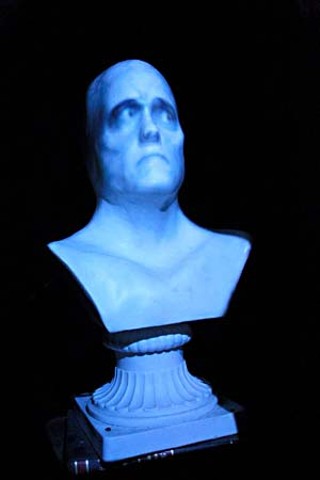
Having that permanent base changes the year for Team Torment, giving them more time to design and build a world-class haunt. Combined with this year's decision to make the build Team Torment's full-time job, their artistic and technical vision took flight on a scale that had never been possible previously. "Last November we said, 'Let's do the event we've always wanted to do,'" says Love. The result is bigger, more elaborate, and more complicated than anything they ever attempted before, from running water to overhead zip lines. It also made business sense: With the extra time, the team could design and build everything themselves, rather than depend on contractors. Love explains, "It's interesting to see what you can do in four or eight weeks, and then when you're given 50 weeks, how much you can exceed your own expectations."
The result is more than people in masks leaping out of cabinets ("I don't want to hear someone say something generic like 'Welcome to hell,'" Mike Garcia warns auditioning actors). It's really two attractions: Illusion Manner, with its twisted fun-house theme, and Contagium – an interactive horror experience inspired, Matt Garcia admits, by a mix of getting tired of seeing New York destroyed in movies and the Austin-based conspiracy theories of Alex Jones. Initially, Matt found his own idea daunting. "I procrastinate, because I like to wait until other horror ideas inspire me," he explains. "With the idea of an apocalyptic city, it created limitations, because you can only do buildings and stores and city streets, so there were no graveyards or spook houses. But it reassured me that this was something that no one else had done."
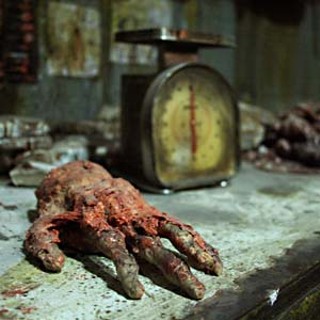
Every night is a different challenge. Repairs are constant, actors may drop out under the strain of a six-hour shift of scaring, and then there's the biggest problem – flow. Getting people through a haunted house smoothly is a complicated balance, maximizing their experience while maximizing the number of people through the door in any one night. Night-vision cameras throughout the building mean props are activated from a hidden control room at just the right second for maximum effect. But the footage also allows the team to see choke points where people get stuck, allowing them to finesse the flow. The same applies for the people waiting to get in. "We know there's a line outside," says McCullough, "but we don't ever have to experience that." He got some insight into his customers' pain on a visit to Las Vegas. "We stood in the cue for a buffet for two hours. It was grueling. The food was great, but it was overshadowed by having to wait that long." That insight lead to this year's biggest innovation: not some new monster but timed tickets, sold online, "just like when you'd go to the movies," McCullough explains.
But after a year of living in the House of Torment, how does the team still know what's scary? "To me, things that are scary are things that are unknown and that we don't understand," Matt explains. "As long as we keep reinventing and reimagining what horror is, it keeps it fresh."
Thursday through Sunday, Oct. 3-12, and every day from Oct. 16 to Nov. 2, 7pm-12mid. 523 Highland Mall Blvd., across from Macy's. Single attraction, $15; combo pass, $20. www.thehouseoftorment.com.





